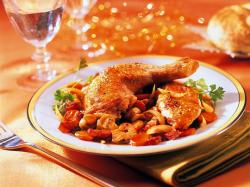Coq Au Vin The Most Famous Of All French Chicken Dishes
March 4, 2010 | 1 min to read

On a recent weekday morning, we joined Christiane Bruelemans-Fick in her Rock
Island kitchen to watch her make Coq au Vin, a signature Julia Child dish that,
literally translated from the French, means Rooster in Wine.
Its a kind of savory stew studded with pieces of chicken, pearl onions and
mushrooms, and is probably the most famous of all French chicken dishes
Christiane had all the ingredients cut up, measured and laid out when we
arrived, and, as a salute to Julia, was wearing a pearl necklace along with her
Belgian chefs apron.
To read the rest of this story please go to:
The Quad City Times
